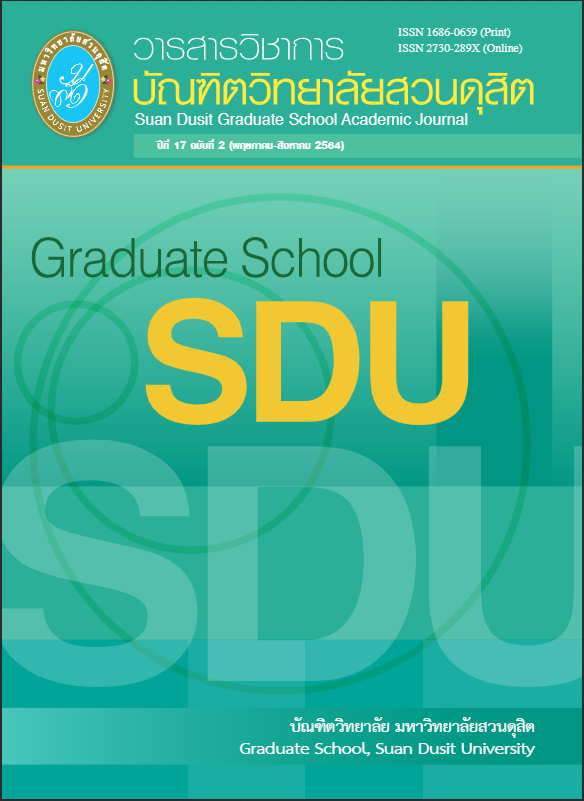โมเดลสแกมเปอร์ (SCAMPER) ความคิดเชิงนวัตกรรมสำหรับการสร้างความแตกต่างด้านแบรนด์และประสบการณ์ลูกค้า: กรณีศึกษา บริษัท การบินไทย จำกัด (มหาชน)
คำสำคัญ:
สายการบิน, แบรนด์หรู, ความยืดหยุ่นด้านราคา, ประสบการณ์ของลูกค้า, การบินไทยนานาชาติบทคัดย่อ
การวิจัยครั้งนี้มีวัตถุประสงค์ดังนี้ 1) เพื่อระบุและสร้างแนวคิดเชิงนวัตกรรม ในภาคธุรกิจ SCAMPER เพื่อดึงดูดลูกค้าหรือผู้โดยสารที่มีกำลังซื้อสูง 2) เพื่อระบุปัจจัยที่ทำให้ลูกค้าหรือผู้โดยสารยินดีจ่ายราคาสูงกว่า สายการบินต้นทุนต่ำถึง 2 เท่า ซึ่งงานวิจัยนี้ เป็นงานวิจัยแบบผสมผสาน (Mixed Method) ระหว่างเชิงคุณภาพ และเชิงปริมาณ โดยการวิจัยครั้งนี้ได้ใช้วิธีการสุ่มกลุ่มตัวอย่างตามคุณสมบัติเฉพาะในเชิงคุณภาพจำนวน 11 คน และในเชิงปริมาณจำนวน 170 คน สำหรับเครื่องมือที่ใช้ในการเก็บรวบรวมข้อมูล ได้แก่ แบบสัมภาษณ์ แบบมีโครงสร้าง จำนวน 7 ข้อ และแบบสอบถาม จำนวน 29 ข้อ ที่ได้ผ่านการคัดกรองในเชิงเนื้อหา ซึ่งผล การวิจัยเชิงคุณภาพจากการสัมภาษณ์ พบว่า การร่วมมือกับกิจการอื่น ๆ อาทิ การบริการวีซ่า การปรับเปลี่ยน เครือข่ายออนไลน์ เช่น การปรับปรุงเว็บไซต์ โดยเฉพาะการบริการในราคาที่สมเหตุสมผล หรือการเพิ่มสื่อ ดิจิทัลความบันเทิง การเพิ่มเก้าอี้นวดบนเครื่องบิน ฯลฯ จะทำให้ลูกค้ายินดีจ่ายค่าบริการมากกว่า ผลวิจัยเชิง ปริมาณจากแบบสอบถามและการวิเคราะห์ด้วยสถิติเชิงบรรยาย สถิติเชิงอนุมาน เช่น ค่าสหสัมพันธ์ การ วิเคราะห์ถดถอยเชิงเส้นแบบพหุ (Multiple linear regression analysis) พบว่า ลูกค้ายินดีจ่ายราคาสูงขึ้น มากกว่า 2 เท่า หากสายการบินไทยปรับปรุงตามประสบการณ์ลูกค้า เช่น 1) หากการบินไทยปรับประดับ มาตรฐานบริการบนเครื่องบินที่ดีกว่าไม่ได้กระตุ้นให้ผู้โดยสารจ่ายเงินราคาสูงมากขึ้น 2) สื่อดิจิทัลบันเทิงบน เครื่องบิน (β.245, α 0.017) 3) จัดหาเครื่องบินสภาพใหม่แทนมือสอง (β.276, α 0.003) ส่งผลให้ยินดีจ่าย สูงขึ้นมากกว่า 2 เท่าเอกสารอ้างอิง
ชาย เอี่ยมศิริ. (2564). การบินไทยประกาศผลการดำเนินงานปี 2563. สืบค้นเมื่อ 18 มีนาคม 2564 จาก https://www.thaiairways.com/th_TH/news/news_announcement/news_detail/THAI-Announces-Operating-Results-2020.page.
บริษัท การบินไทย จำกัด (มหาชน). (2564). ประกาศปรับโครงสร้างวันนี้ ลดพนักงานครึ่งหมื่น. สืบค้นเมื่อ 18 มีนาคม 2564 จาก https://news.thaipbs.or.th/content/302185.
Anderson, P. L., McLellan, R. D., Overton, J. P. & Wolfram, G. L., Dr. (1997). Price Elasticity of Demand. United States: Harvard University
Athwal, Navdeep & Harris, Lloyd. (2018). Examining How Brand Authenticity is Established andMaintained: The Case of the Reverso. Journal of Marketing Management, 34 (3); 1-23.
Braun, V., Clarke, V. & Weate, P. (2016). Using thematic analysis in sport and exercise research in sport and exercise research. In Routledge handbook of qualitative research in sport and exercise: United States: Taylor & Francis (Routledge).
Camilleri, M. (2018). The Airline Business. In Travel marketing, Tourism Economics and the Airline Product: An Introduction to Theory and Practice. Italy: Springer.
IATA. (2004). Corporate Air Travel Survey. Retrieved on September 18, 2020 from https://www.iata.org/en/pressroom/pr/2005-03-04-02/.
Filieri, R., & Mcleay, F. (2013). E-WOM and Accommodation: An Analysis of the Factors That Influence Travelers’ Adoption of Information from Online Reviews. Journal of Travel Research, 53 (1); 44-57.
Gillen, D. (2006). Airline Business Models and Networks: Regulation, Competition and Evolution in Aviation Markets. Review of Network Economics, 5(4), 366-385.
Gitman, L. J., & McDaniel, C. D. (2008). The Future of Business. Australia: Thomson/South- Western.
Heine, K. (2012). The Concept of Luxury Brands. Germany: TU Berlin.
Kapferer, J. N. (2017). The End of Luxury as We Knew it?. Retrieved on September 18, 2020 from https://www.researchgate.net/publication/281803401_The_New_Strategic_Brand_Management.
Kumar, V. & Batista, L. & Maull, R. (2011). The Impact of Operations Performance on Customer Loyalty. Service Science, 3(1); 158-171.
Kumthonkittikul, W. (2020). An innovative SCAMPER Model for Thai Airways to Improve its Brand Proposition and Customer’s Experience Master of Business Innovation.Independent Study of Master of Business Innovation Program IKI-SEA Bangkok University.
Laming, C., & Keith, M. (2014). Customer Experience: An Analysis of the Concept and Its Performance in Airline Brands. Research in Transportation Business & Management, 10 (1); 15-25.
Levitt, T.(1965). Exploit The Product Life Cycle. Harvard Business Review. Retrieved on September 18, 2020 from https://hbr.org/1965/11/exploit-the-product-life-cycle.
Mazareanu, E. (2020). Global Air Traffic-scheduled Passengers 2004-2021 Retrieved on September 18, 2020 from https://www.statista.com/statistics/564717/airline-industrypassenger-traffic-globally/.
Mišetić, I. & Steiner, S. & Tatalović, M. (2007). Airline Marketing Factors. Strategic Modelling of Air Transport Development. Promet-Traffic–Traffico, 19 (1); 11-19.
Palnychenko, D. (2017). Perception of Service in Airlines: A Comparison of Generation X and Generation Y. Bachelor of Science Thesis Faculty of International Business Management Program Modul University.
Pongpanich, B. (2020). Rescuing Thai Airways, What Does Thai People Get or Should Let It Go Bankrupt? (Trans.). Retrieved on September 18, 2020 from https://youtu.be/fVAPUJwfBIo.
Sirbiladze, K. (2017). Scamper Technique for Creative Thinking. Retrieved on September 18, 2020 from https://er.knutd.edu.ua/bitstream/123456789/7479/1/20170321_EconFinance_V2_P037-040.pdf.
Thai Airways International Public Company. (2011). Annual Report 2010. Bangkok.
The Standard. (2020). อุ้มการบินไทย คนไทยได้อะไร หรือควรปล่อยให้ล้มละลาย?. Retrieved on September 18, 2020 from https://thestandard.co/podcast_tag/thai-airways/.
Vlachos, I., & Lin, Z. (2014). Drivers of Airline Loyalty: Evidence from the Business Travelers in China. Transportation Research Part E: Logistics and Transportation Review, 71 (1); 1–17.
Wakefield, R. (2001). Service quality. The CPA Journal, 71 (8); 58-60.
Wongsuwan, W. (2016). A study on service quality and customer satisfaction: a comparison between a premium airline and a low-cost long-haul airline.Language Institute, Thammasat University. Retrieved on September 18, 2020 from http://ethesisarchive.library.tu.ac.th/thesis/2015/TU_2015_5721040912_4417_2357.pdf.
ดาวน์โหลด
เผยแพร่แล้ว
รูปแบบการอ้างอิง
ฉบับ
ประเภทบทความ
สัญญาอนุญาต
ลิขสิทธิ์ (c) 2021 วารสารวิชาการบัณฑิตวิทยาลัย สวนดุสิต

อนุญาตภายใต้เงื่อนไข Creative Commons Attribution-NonCommercial-NoDerivatives 4.0 International License.






